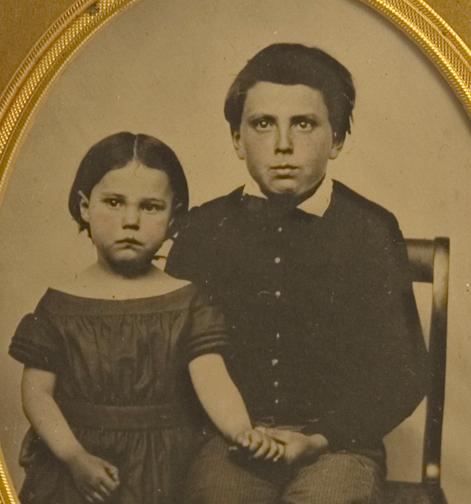
United States Photographic Industry: Ambrotypes

Figure 1.--This Ambrotype portrait ofa boy nd his little sister was probably taen in the late-1850s. The military-styled collar-buttoning jacket was very popular in the 1850s and early-6os. We think that these jackets were also worn in the 1840s, but can not yet confirm this.
|
|
Research developments from Europe continued to dominatephotogrphy. Frederick Scott Archer in Britain invented the wet plate collodion process (early-1850s). Amrotypists used the plate image as a positive, instead of a negative. James Ambrose Cutting of Boston was one of the first American Ambrotypists. Cutting filed for several related patents (1854). His first namne is probbly the origin of the term Ambrotype which is the accepted American term for the process. As with Dags, the number of available American Ambros is much larger than is the case in Europe. This appears to reflect the growingprosperity of the United States combined with the weakness of patent law. And as with Dags, most were done as cased images which was less common in Europe. Most American Ambrotypes thus date from mid-decade (1855). The new process rapidly grew in popularity. This was about the same time that the tin-type appeared. They had one big advantage over Daguerreotypes, they were much less expensive which of course ffected the numbers made. They eliinated the need or apolished metal plae. Instead a simple inexpenive piece of glass was used. The Ambrotype was a collodion image fixed to the glass plate. When held up to a light source, it looked like a negative. To create a positive aeffect, the back of the plate could be painted black or set in black background. Both Daguerreotypes and Ambrotypes had the same disadvantage, they were unique objects. There was no negative. Thus copies could not be made to send to families and friends. For the most part, like Dags we often do not know who the photgrapher was. Ambros like Dags were rarely dates, but as they were made over a relatively narrow time frame, we know about when the images were made. Nost Aerican Ambros were made about 1855-63. After 1863 Ambros begin to became rare as the CDV became the standard photographic format. One useful utility of the Ambroptype is helping the date Dags which were made over auch longer time frame. If we do not see see fashions in Ambros that we do see in Dags, we can assume that the Dag dates to the 1840s or early-50s. We think Ambros were made in larger numbers than Dags which is also a helpful clue in dating, but this needs to be confirmed.
HBC

Navigate the Boys' Historical Clothing Web Site:
[Return to the Main U.S. photography page]
[Return to the Main photographic country page]
[Return to the Main Ambrotype page]
[Return to the Main U.S. page]
[Introduction]
[Activities]
[Biographies]
[Chronology]
[Clothing styles]
[Countries]
[Essays]
[Bibliographies]
[Contributions]
[FAQs]
[Glossaries]
[Images]
[Links]
[Registration]
[Tools]
[ Boys' Clothing Home]
Created: 5:42 AM 9/25/2012
Last updated: 5:42 AM 9/25/2012



